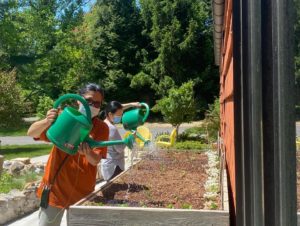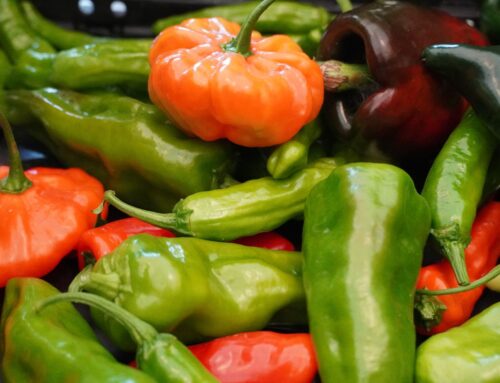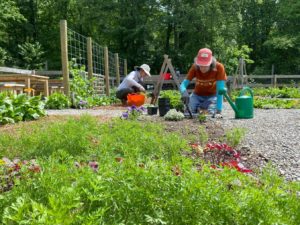
Along with soil and sunlight, water is essential for a healthy and successful garden. Yet, watering a vegetable garden can be tricky. Water too much and the plants will become prone to disease. Water too little and your vegetables will be small, resulting in a greatly reduced harvest. So, the question then is how you know when and how to water your vegetable garden.
Most vegetables are 70-95% water! For vegetables to grow well they need to get nutrients from the soil, and then move those nutrients around the plant by the means of water. The following guidelines will help to make sure you give your garden the optimum water it needs for a bountiful harvest.
The first thing to do is to understand your soil. Most soils have three particle sizes: sand, silt, and clay in different combinations. This is important to know because soil that has more clay will retain moisture after rain and manual watering. Sandy soil causes water to travel down quickly, thus not holding onto moisture as readily as clay soil. This means you will have to water more often and pay special attention to how quickly the soil dries out. If you haven’t done a soil sample and thus don’t know your soil type, do not despair. Instead, be experiential and follow the steps outlined in the internet resource provided by “USDA Soil Texture By Feel NCRS Soils”.
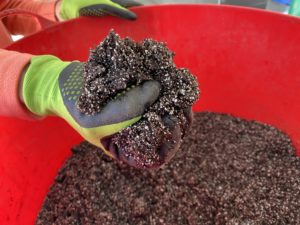
Know how much water your vegetables need. Generally most will need 1” of water per week, which includes rain and manual watering. Remember, keep your soil type and type of vegetable in mind. Some vegetables require less water, and others more water. If you have a vegetable that is beginning to do poorly in your garden, conduct an internet search regarding the water needs of that particular vegetable.
Keep track of how much water your garden is receiving through rainfall. If you want to know how much rain you have gotten in a given week, you can place a simple plastic rain gauge in your garden or a tuna can which when full is about one inch, or if you prefer to be more precise, measure with a plastic ruler. Another alternative is to check out the free app “Pocket Rain Gauge” by Agrible. And If you lose track of how much it has rained, you can always take a trowel and dig down into the soil a bit to see how much soil moisture is still present.
Make sure to water efficiently. Drip irrigation is the most efficient use of water in your garden. Due to the cost factor for set up, many gardeners do not have this option. The next best thing is to make sure you are watering at the base of the plants. Overhead watering, including sprinklers, is inefficient due to water evaporation. In addition, some plants, like squashes, cucumbers, and tomatoes are susceptible to fungal and other diseases if the leaves are left wet from watering. I use a soaker hose attached to a timer so I don’t have to rely on my memory. You may want to look for a timer with a manual override so you can adjust for rainfall in any given week. Another method is to use a heavy-duty garden hose with a watering wand which you should hold at the base of the plant for 30-60 seconds. You can judge when to stop watering by noticing how quickly the water is infiltrating the soil. When the water pools up at the base of the plant, it is time to move on to the next plant.
Water established plants in such a way as to develop deep roots. Plants are more resilient when they are deeply rooted. To encourage your plants to do this you will want to water less often and for a longer duration. Frequent and shallow watering will cause plant roots to stay at the surface of the soil. It is important to note that newly planted seedlings need a little extra watering attention in their first week or two. Therefore, keep the soil moist to encourage them to grow and establish quickly. If you planted seeds and are waiting for them to germinate, you will want to keep the top of the soil moist with a quick soak everyday or every other day with a watering can. Once seeds germinate, you can put them on a once or twice a week watering schedule with the exception being if it is exceptionally hot, then water more often.
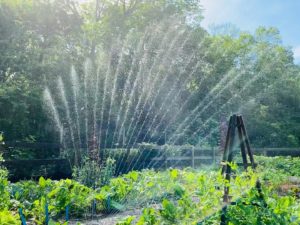
Water in the morning. It will be cooler then, with less chance for water to evaporate. This time will also allow any water that has splashed on the leaves as you were watering at the base of the plant to dry out. This is important because water can encourage some diseases to spread throughout the garden. If you have a busy morning schedule, then you can water in the evening when it is cooler; just be mindful of not getting water on the leaves of your plants. The worst time to water is in the middle of the afternoon.
Mulch, mulch mulch. Without mulch, you will get more weeds which will compete for water with your vegetables. A mulched garden will dry out less quickly. A way to confirm this is to check out the color and texture of your soil that is underneath mulch as compared to soil that is exposed to the sun and elements. Mulches appropriate for vegetable gardens are leaves, hay, or straw (be sure there are no seeds in it or you will have more weeds), grass clippings, pine needles, newspaper, and cardboard. Wood chips can be used for the paths in your garden, but are not recommended for use around vegetables. Mulching is worth the time in the long run, even if it requires more effort in the short run because it helps in the retention of moisture, inhibits weeds, keeps disease issues at bay, and adds organic matter to your soil.
We hope to see you at Lucille’s Garden, where every day, even a rainy one, is a good day!
